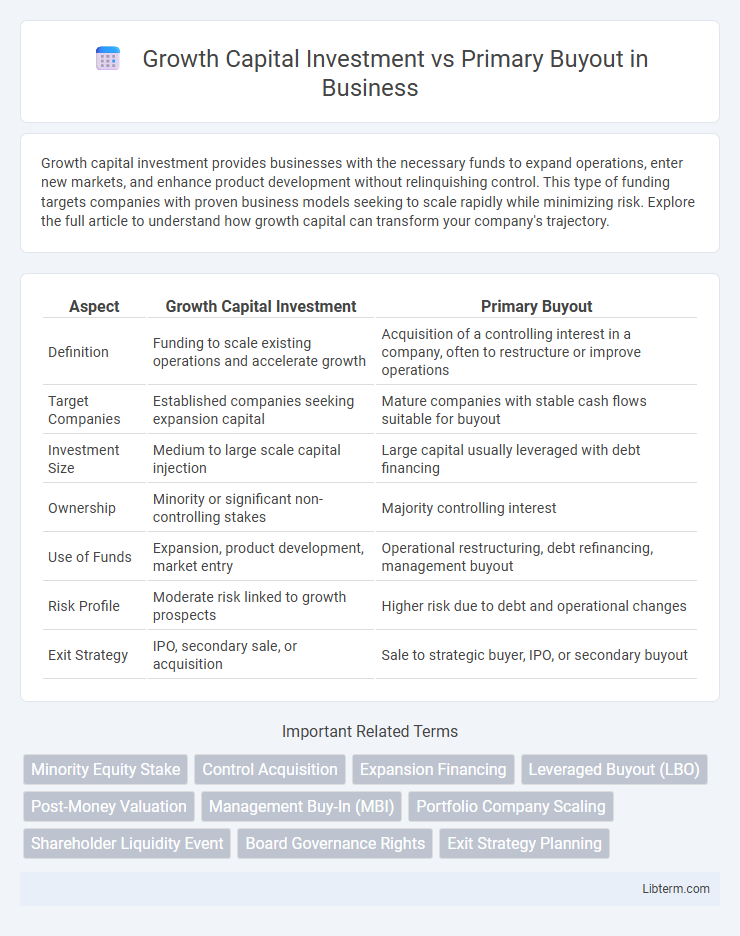Growth capital investment provides businesses with the necessary funds to expand operations, enter new markets, and enhance product development without relinquishing control. This type of funding targets companies with proven business models seeking to scale rapidly while minimizing risk. Explore the full article to understand how growth capital can transform your company's trajectory.
Table of Comparison
| Aspect | Growth Capital Investment | Primary Buyout |
|---|---|---|
| Definition | Funding to scale existing operations and accelerate growth | Acquisition of a controlling interest in a company, often to restructure or improve operations |
| Target Companies | Established companies seeking expansion capital | Mature companies with stable cash flows suitable for buyout |
| Investment Size | Medium to large scale capital injection | Large capital usually leveraged with debt financing |
| Ownership | Minority or significant non-controlling stakes | Majority controlling interest |
| Use of Funds | Expansion, product development, market entry | Operational restructuring, debt refinancing, management buyout |
| Risk Profile | Moderate risk linked to growth prospects | Higher risk due to debt and operational changes |
| Exit Strategy | IPO, secondary sale, or acquisition | Sale to strategic buyer, IPO, or secondary buyout |
Introduction to Growth Capital Investment and Primary Buyout
Growth capital investment involves providing established companies with capital to expand operations, enter new markets, or finance significant acquisitions without changing control. Primary buyout refers to the acquisition of a controlling stake in a company, often by private equity firms, to improve operational efficiency and drive long-term value creation. Both growth capital and primary buyouts play essential roles in private equity, targeting different stages of a company's lifecycle and strategic objectives.
Defining Growth Capital: Key Characteristics
Growth capital investment targets established companies seeking funds to expand operations, enter new markets, or finance significant acquisitions without changing control. It typically involves minority equity stakes, allowing original owners to retain decision-making authority while accessing capital for strategic growth initiatives. This contrasts with primary buyouts, where investors acquire controlling interests to restructure or scale businesses extensively.
Understanding Primary Buyouts: An Overview
Primary buyouts involve acquiring a controlling stake in an established company, often to drive strategic growth and operational improvements. Growth capital investment targets expanding businesses by injecting funds without ownership control, whereas primary buyouts require full control for restructuring or scaling. Understanding primary buyouts is essential for investors aiming to enhance value through active management and governance changes.
Investment Objectives: Growth Capital vs Primary Buyout
Growth capital investment targets expanding companies needing funds to accelerate development, increase market share, or launch new products, focusing on minority stakes to support operational growth without changing control. Primary buyout investments acquire controlling interests in mature companies, aiming to improve efficiency, streamline operations, and enhance long-term value through strategic management changes. Both investment types prioritize value creation but differ in risk profiles and involvement, with growth capital emphasizing growth potential and primary buyouts focusing on restructuring and control.
Risk Profiles and Return Expectations
Growth capital investments typically involve providing capital to mature companies seeking expansion, carrying moderate risk due to established revenue streams and proven business models, with return expectations ranging from 15% to 25%. Primary buyouts involve acquiring controlling stakes in companies, often through leveraged transactions, presenting higher risk linked to debt levels and operational restructuring, but promising higher returns, commonly between 20% and 30%. Investors weigh these risk-return profiles by assessing market conditions, company performance, and exit strategies to optimize portfolio diversification and achieve targeted returns.
Typical Investors and Stakeholders Involved
Growth capital investments typically attract venture capital firms, family offices, and institutional investors seeking minority stakes to support company expansion without changing control, involving founders and existing shareholders as primary stakeholders. Primary buyouts mainly engage private equity firms aiming for majority control to restructure or scale businesses, involving management teams, shareholders, and sometimes debt providers as key stakeholders. Both investment types require active collaboration among investors, company executives, and sometimes strategic partners to align growth objectives and operational plans.
Target Companies and Sector Suitability
Growth capital investments typically target expanding companies with proven business models in sectors like technology, healthcare, and consumer services requiring funds for scaling operations or market expansion. Primary buyouts focus on acquiring controlling stakes in mature firms across industries such as manufacturing, financial services, and retail, where management buy-ins or buyouts facilitate strategic restructuring. Sector suitability depends on growth potential and stability, with growth capital favoring high-growth, innovation-driven markets and primary buyouts suited for stable, cash-generative businesses needing operational improvements.
Deal Structures and Financing Methods
Growth capital investment typically involves minority equity stakes in established companies seeking expansion, with deal structures favoring flexible equity or convertible securities and financing methods relying on a mix of equity and mezzanine debt. Primary buyouts usually entail majority ownership acquisition, where deal structures incorporate leveraged buyout techniques and financing methods extensively utilize senior and subordinated debt to optimize capital structure. The contrasting approaches reflect differing risk profiles and control objectives, with growth capital emphasizing supportive partnership and primary buyouts prioritizing operational control and financial engineering.
Value Creation Strategies Compared
Growth capital investment targets expanding companies by providing funds to accelerate revenue, scale operations, and enter new markets, emphasizing organic growth and innovation-driven value creation. Primary buyouts involve acquiring controlling stakes in mature firms, focusing on operational improvements, cost optimization, and strategic repositioning to enhance profitability and cash flow. Both strategies drive value creation, but growth capital leans towards capital infusion for expansion, while buyouts prioritize restructuring and performance enhancement.
Choosing the Right Approach: Factors to Consider
Choosing between growth capital investment and primary buyout depends on the company's stage, capital requirements, and control preferences. Growth capital suits businesses seeking funds for expansion without ceding majority control, while primary buyouts typically involve acquiring controlling stakes in mature companies. Key factors include the desired level of ownership, risk tolerance, and the company's growth trajectory.
Growth Capital Investment Infographic

 libterm.com
libterm.com